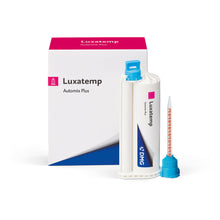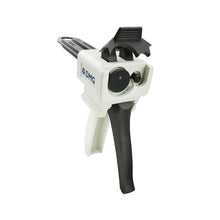Luxatemp® Plus - Provisional Material
Luxatemp Plus by DMG delivers strong, long-lasting temporaries with excellent marginal fit & high esthetics. Ideal for crowns, bridges & inlays.
- Negligible linear shrinkage and heat production during polymerization
- High flexural strength
- Neutral taste, no odour or stinging of gingiva
- Durable and long-lasting temporary restorations
- Optimized resistance to abrasion
- High biocompatibility
- Exceptional fit
Curion is proud to be an authorized distributor of DMG products in Canada. This product is backed by the manufacturer's warranty.

Proven success material for temporary crowns and bridges
Luxatemp Automix Plus is used to create provisional restorations for placement in the patient's mouth during indirect and prosthodontic treatments. Luxatemp Automix Plus provides extremely accurate provisionals with excellent marginal adaptation and negligible linear shrinkage during polymerization, eliminating the need to re-marginate. It produces durable and long-lasting temporaries that are abrasion resistant and easily removable.
The high hardness prevents wearing down of bridges eliminating the perforations of the provisional and the risk of saliva, bacteria and thermal irritants reaching the tooth. The fabrication of provisionals can be done directly in the patient’s mouth with no heat damage to pulp or tissue due to minimal heat production during polymerization.
The quick, easy-to-use dispensing Automix delivery system saves time and money and eliminates waste while allowing for easy control of the material being dispensed. The cartridge incorporates distinctly separate outlets for base and catalyst preventing material cross-contamination which can lead to the material not setting.
Specially designed Mixing Tips provide an exact 10:1 base/catalyst ratio guaranteeing a thorough mix every time, color stability, minimizing porous surfaces, reducing staining from coffee, tea, etc. and no air bubble voids.
Its neutral taste and lack of odor is a patient-friendly material. Available in five lifelike shades: A1, A2, A3.5, B1 and Bleach Light.
Luxatemp Automix Plus Physical Properties
| Property | Value |
| Chemistry | Bisacryl |
| Mixing Ratio (Catalyst/Base) | 1:10 |
| Compressive Strength | 220 MPa |
| Transverse Strength | 80 MPa |
| Diametrical Tensile Strength | 36 MPa |
| Barcol Hardness | 35 |
| Water sorption | 10 ug/mm |
| Maximum Temperature During Polymerization | 38˚C / 100˚F |
 | “Having been in clinical practice for over 30 years and educating other dentists for the past 25, there are only a few products that stand out as the very best! One of these is Luxatemp. Since my initial use in 1996, to the restorative case I prepared and provisionalized yesterday, this is definitely a product I could not be without. Other provisional materials may claim they are equal to Luxatemp, but that is just not the case and no other provisional material has stood the test of time and proven its excellence like Luxatemp. I use it in my practice daily and it has been my material of choice in all of my live-patient hands-on courses for the past 20+ years.” — Dr. David S. Hornbrook |
Beadline Technique with Dr. Todd Snyder
Quick Guide for fabricating temporaries with Luxatemp Ultra, Luxatemp Plus, Luxatemp Fluorescence
Frequently Asked Questions
Yes, acrylic bonds to Luxatemp. Ensure surface is clean. Lightly abrade the pertinent spot on the restoration with a cutter or sandblaster. Apply monomer from acrylic to Luxatemp and then add acrylic to it.
Yes, ensure the area is clean. Then lightly abrade the area of the restoration with a cutter or sandblaster. Apply a bonding agent in accordance with the directions for use and add Luxatemp.
Luxatemp Ultra has a greater degree of flexural strength compared to Luxatemp Plus or Luxatemp Florescence. Luxatemp Ultra is recommended since it is the latest product within the Luxatemp family of products; however, product recommendation will vary depending on product being currently used and whether an issue is being experienced as well as the nature of the issue.
Luxatemp does not contain sulfur or sulfuric compounds such as sulfites.
When composite material sets, a very thin layer of non-hardened acrylic is present due to the presence of atmospheric oxygen that prevents the acrylic from setting completely.
The smear layer can be easily removed with alcohol.
- Luxatemp Ultra: A1, A2, A3, A3.5, B1 and Bleach Light
- Luxatemp Fluorescence: A1, A2, A3, A3.5, B1 and Bleach Light
- Luxatemp Plus: A1, A2, A3.5, B1 and Bleach Light
Luxatemp is available in Automix cartridges for a 10:1 dispenser and Smartmix syringe.
You can make 34-38 single crowns from one cartridge.
You can make 23-25 three-unit bridges from one cartridge.
You can make approximately 10 single crowns from one Smartmix syringe.
You can make approximately 5 three-unit bridges from one Smartmix syringe.
Leave the used mixing tip on the cartridge as a cap.
45 seconds.
Luxatemp Ultra should be removed during the elastic phase, i.e. 1:30-2:20 minutes after mixing Luxatemp Ultra. The time applies for intraoral application. Outside of the mouth, the time value doubles. The setting process should be monitored with a probe or with a sample of the material placed on the hand and tested for a “gummy bear” consistency.
Luxatemp Plus is chemically cured. Luxatemp Solar is light cured which is the reason for the black cartridge.
The setting of the cement may be inhibited.
The temperature of Luxatemp Plus during polymerization is low (approximately <40° depending on the measurement method). It also does not contain any methyl methacrylates or peroxide which minimizes the risk of an allergic reaction and prevents gum irritation.
Bubbles can be avoided by keeping the mixing tip immersed in the material preventing air from becoming trapped.
Yes, Luxatemp Plus is biocompatible because it does not contain methyl methacrylates which minimizes the risk of an allergic reaction. Additionally, the temperature of Luxatemp Plus during polymerization is low (approximately <40° depending on the measurement method).
Luxatemp does not contain gluten.
Luxatemp does not contain BPA, metal or fluoride
With Luxatemp Solar the elastic phase can be prolonged because final polymerization is done by light curing which makes it well-suited for multi-unit bridges.
Generally, long-term temporaries made with Luxatemp can remain in the mouth for roughly 6 months.
Temporaries can be repaired with LuxaFlow Ultra.




